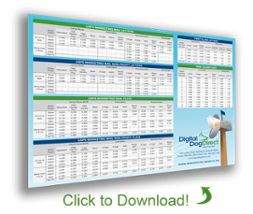 It’s that time of year to begin a performance analysis of your 2018 direct marketing strategy so that you can make adjustments and hit the ground running in 2019. You may need to do some digging, but there are several metrics necessary to factor the measurable values used to determine ROI for various marketing initiatives.
It’s that time of year to begin a performance analysis of your 2018 direct marketing strategy so that you can make adjustments and hit the ground running in 2019. You may need to do some digging, but there are several metrics necessary to factor the measurable values used to determine ROI for various marketing initiatives.
These Key Performance Indicators (KPIs) vary among different brands, revenue streams, and marketing channels. For the purpose of this blog, we’ll focus on the performance of direct marketing activity as it relates to a business unit.
2019 KPIs for Analysis Include:
- Direct Mail Marketing Budget — Print, Postage, Lists, Lettershop, Creative
- Number of Outbound Leads — Leads generated by direct mail and email
- Cost Per Lead Acquisition — Total the annual direct mail and digital investment, then divide by the number of leads generated.
- Lead-to-Customer Ratio — Determine the percentage of leads that become paying customers vs. those that have yet to buy.
- Size of House File — How much did your current customer and qualified prospect database grow over the year?
- Lifetime Value — Your ROI should factor in repeat business going forward per lead. Calculate this by multiplying (Average Sale) x (Average Number of Purchases per Year) x (Average Retention Time in Years).
- Direct Mail & Email Response Rates — Which campaigns drove the most leads by phone or web visits? Use this data to fine tune creative, timing, and frequency.
- Landing Page Conversion Rates — If this could be higher, test various elements such as color, copy, images, and extent of information required on the form.
- Website Traffic — Run Google Analytics reports and track spikes surrounding direct mail drop dates and clickthroughs on links promoted through mailings.
- Sales Generated from Print & Digital — As you track leads, repeat buyers stimulated by marketing, and reactivated dormant customers, add up their total purchases over the course of the year. Subtract the total amount spent to arrive at a general ROI.
As the KPI numbers come into view you can drill down to performance indicators by specific initiatives and campaigns to gauge what’s working and where you may have come up short. This intel can be used to adjust creative, budgeting, and marketing tactics to optimize performance in the year to come.
This is also a good time of year to update the KPI metrics that you want to follow in the near future. Be sure to write clear, actionable objectives for each KPI and share the KPI plan with stakeholders to monitor going forward. This will help keep everyone on the same page and motivated to achieve common goals.
This article was originally published in September 2017 and has been updated.



Comments